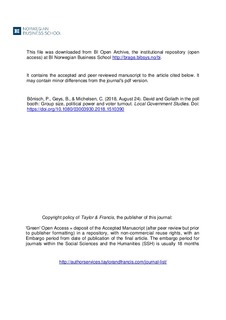| dc.contributor.author | Bönisch, Peter | |
| dc.contributor.author | Geys, Benny | |
| dc.contributor.author | Michelsen, Claus | |
| dc.date.accessioned | 2018-11-09T11:36:15Z | |
| dc.date.available | 2018-11-09T11:36:15Z | |
| dc.date.created | 2018-07-09T15:56:21Z | |
| dc.date.issued | 2018 | |
| dc.identifier.citation | Local Government Studies, 2018, August 24 | nb_NO |
| dc.identifier.issn | 0300-3930 | |
| dc.identifier.issn | 1743-9388 | |
| dc.identifier.uri | http://hdl.handle.net/11250/2571784 | |
| dc.description.abstract | This article analyses how the presence of a dominant group of voters within the electorate affects voter turnout. Theoretically, we argue that its absolute size affects turnout via increased free-riding incentives and reduced social pressure to vote within a larger dominant group. Its relative size compared to other groups within the electorate influences turnout through instrumental and expressive responses – in both the dominant and dominated groups – to the degree of electoral competition between groups. Empirical evidence from a large cross section of German municipalities is in line with these theoretical predictions. The observed effects should be taken into account when redesigning electoral jurisdictions through, for instance, municipal mergers or gerrymandering. | nb_NO |
| dc.language.iso | eng | nb_NO |
| dc.publisher | Tylor and Francis | nb_NO |
| dc.title | David and Goliath in the Poll Booth: Group Size, Political Power and Voter Turnout | nb_NO |
| dc.title.alternative | David and Goliath in the Poll Booth: Group Size, Political Power and Voter Turnout | nb_NO |
| dc.type | Journal article | nb_NO |
| dc.type | Peer reviewed | nb_NO |
| dc.description.version | acceptedVersion | nb_NO |
| dc.source.journal | Local Government Studies | nb_NO |
| dc.identifier.doi | 10.1080/03003930.2018.1510390 | |
| dc.identifier.cristin | 1596435 | |
| dc.description.localcode | 1, Forfatterversjon | nb_NO |
| cristin.unitcode | 158,3,0,0 | |
| cristin.unitname | Institutt for samfunnsøkonomi | |
| cristin.ispublished | false | |
| cristin.fulltext | postprint | |
| cristin.qualitycode | 1 | |
